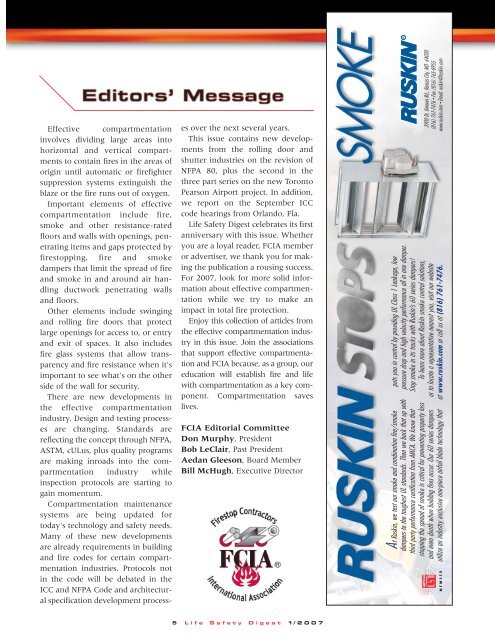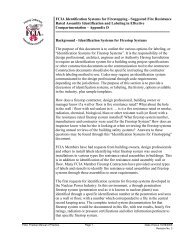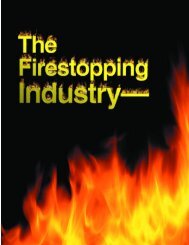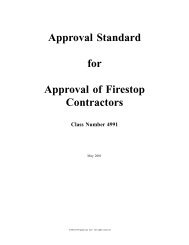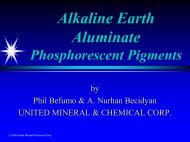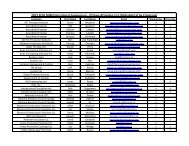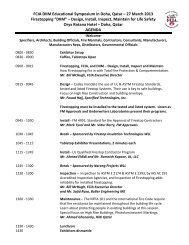Winter 2007 - FCIA - Firestop Contractors International Association
Winter 2007 - FCIA - Firestop Contractors International Association
Winter 2007 - FCIA - Firestop Contractors International Association
Create successful ePaper yourself
Turn your PDF publications into a flip-book with our unique Google optimized e-Paper software.
R<br />
Effective compartmentation<br />
involves dividing large areas into<br />
horizontal and vertical compartments<br />
to contain fires in the areas of<br />
origin until automatic or firefighter<br />
suppression systems extinguish the<br />
blaze or the fire runs out of oxygen.<br />
Important elements of effective<br />
compartmentation include fire,<br />
smoke and other resistance-rated<br />
floors and walls with openings, penetrating<br />
items and gaps protected by<br />
firestopping, fire and smoke<br />
dampers that limit the spread of fire<br />
and smoke in and around air handling<br />
ductwork penetrating walls<br />
and floors.<br />
Other elements include swinging<br />
and rolling fire doors that protect<br />
large openings for access to, or entry<br />
and exit of spaces. It also includes<br />
fire glass systems that allow transparency<br />
and fire resistance when it's<br />
important to see what's on the other<br />
side of the wall for security.<br />
There are new developments in<br />
the effective compartmentation<br />
industry. Design and testing processes<br />
are changing. Standards are<br />
reflecting the concept through NFPA,<br />
ASTM, cULus, plus quality programs<br />
are making inroads into the compartmentation<br />
industry while<br />
inspection protocols are starting to<br />
gain momentum.<br />
Compartmentation maintenance<br />
systems are being updated for<br />
today's technology and safety needs.<br />
Many of these new developments<br />
are already requirements in building<br />
and fire codes for certain compartmentation<br />
industries. Protocols not<br />
in the code will be debated in the<br />
ICC and NFPA Code and architectural<br />
specification development processes<br />
over the next several years.<br />
This issue contains new developments<br />
from the rolling door and<br />
shutter industries on the revision of<br />
NFPA 80, plus the second in the<br />
three part series on the new Toronto<br />
Pearson Airport project. In addition,<br />
we report on the September ICC<br />
code hearings from Orlando, Fla.<br />
Life Safety Digest celebrates its first<br />
anniversary with this issue. Whether<br />
you are a loyal reader, <strong>FCIA</strong> member<br />
or advertiser, we thank you for making<br />
the publication a rousing success.<br />
For <strong>2007</strong>, look for more solid information<br />
about effective compartmentation<br />
while we try to make an<br />
impact in total fire protection.<br />
Enjoy this collection of articles from<br />
the effective compartmentation industry<br />
in this issue. Join the associations<br />
that support effective compartmentation<br />
and <strong>FCIA</strong> because, as a group, our<br />
education will establish fire and life<br />
with compartmentation as a key component.<br />
Compartmentation saves<br />
lives.<br />
<strong>FCIA</strong> Editorial Committee<br />
Don Murphy, President<br />
Bob LeClair, Past President<br />
Aedan Gleeson, Board Member<br />
Bill McHugh, Executive Director<br />
3900 Dr. Greaves Rd., Kansas City, MO 64030<br />
(816) 761-7476 • Fax (816) 765-8955<br />
www.ruskin.com • Email: ruskin@ruskin.com<br />
puts you in control by providing UL Class 1 Leakage, low<br />
pressure drop and high velocity performance all in one damper.<br />
Stop smoke in its tracks with Ruskin’s 60 series dampers!<br />
To learn more about Ruskin smoke control solutions,<br />
or to locate a representative nearest you, visit our website<br />
at www.ruskin.com or call us at (816) 761-7476.<br />
A t Ruskin, we test our smoke and combination fire/smoke<br />
dampers to the toughest UL standards. Then we back that up with<br />
third party performance certification from AMCA. We know that<br />
stopping the spread of smoke is critical for preventing property loss<br />
and even death when building fires occur. Our 60 series dampers<br />
utilize an industry exclusive one-piece airfoil blade technology that<br />
5 Life Safety Digest 1/<strong>2007</strong>


